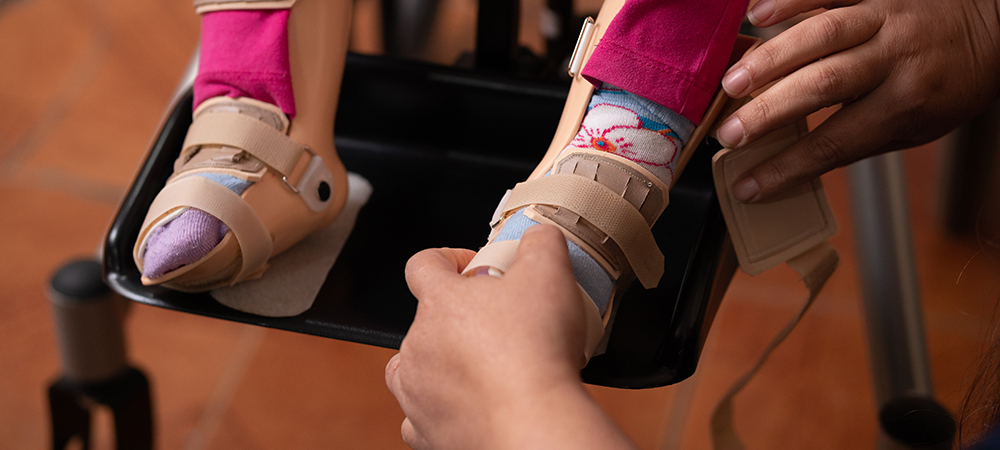Using the latest technology, Algeos and Voxelcare have set out to transform the healthcare industry. Max Sheridan, Managing Director of Algeos, and Simon McClements, International Business Development Manager, Voxelcare, speak to us about the companies’ partnership and Voxelcare’s 3D printer, set to revolutionise foot orthopaedics and lower limbs.
Algeos has been chosen to take a revolutionary new product to the UK and Australian market that is set to transform the lower limb healthcare sector.
The firm has been announced as a UK exclusive distributor of the Voxelcare VXC3DP Filament Cube printing unit, which enables clinicians to print foot orthotics and other materials in-house in half the time, reducing waste and manufacturing time and NHS waiting lists in the process. The printing unit is ideal for private practice and clinical business development and is also scalable for fast-paced orthotic manufacturers.
The printing unit contains a 3D printer that can operate as its own system and has been officially launched.
Algeos is a world-leading innovator and manufacturer of podiatry, orthotics and footwear products and technologies, and has been keeping people moving for 140 years. With a global customer base and supplying 85% of the 295 NHS trusts across the UK, Algeos is in a unique position to take the product and scale it up very quickly for the lower limb healthcare sector.
Max Sheridan, Managing Director of Algeos, says the product will be key in reducing amputation rates among diabetic patients through prevention. Diabetes is a leading cause of amputation.
“As well as treating a wide range of conditions, this kit will also go a long way in helping diabetic patients and preventing future amputations and complications,” said Sheridan. “For me, this is all about prevention rather than wound management and rehabilitation, and we are keen to buck the trend in the sector. There is so much evidence out there that shows how foot orthotics can help offload pressure for diabetic patients – in turn, saving limbs and lives. We will work with MSK clinicians as well as the patient to make sure they make the right choices in terms of the orthotic care they receive.
“The foot orthotics created by the technology will be lightweight, making them ideal for sportspeople including cyclists, golfers, runners and triathletes. They will be slim, lightweight, and able to insert easily into all different types of sports footwear.”
Discussing the clinical outcomes of the 3D printing unit, Sheridan also highlighted how it will help provide a new revenue stream for private clinicians and business development managers looking to increase ROI.
“With the production of foot orthotics, we’re starting to see a big demand from private clinics and physicians looking to take the Voxelcare VXC3DP Filament Cube printing unit on and adopt the new technology.
“Due to the unique scanning options that can be used on iPad, iPhone and a laptop, the 3D printer is ideal for clinical retail, private practices and the NHS. The production of foot orthotics is a rapidly growing market and we are hoping to expand awareness of this new, cost-effective product across the UK and Australia.”
Commenting on the partnership, Simon McClements, International Business Development Manager, Voxelcare, said the collaboration felt ‘natural’, with Sheridan understanding Voxelcare’s vision and being able to provide vast experience within the UK market.
“Over the years, the knowledge of the team at Algeos has helped Voxelcare learn how to approach things, specifically with how markets differ around the world. They have been excellent at extending the Voxelcare network,” added McClements.
“Each new system in the UK brings value to the growth and innovation of Voxelcare, as we are a company who listens to feedback and uses it constructively to continue innovation. We have just recently renewed our partnership contract with Algeos, and we look forward to working with them for many more years to come.”
After venturing into technology, both companies realised 3D printing was no longer just a buzzword, but now a demand in healthcare. At first, they saw some challenges and how the industry wanted the manufacturing of 3D printing to be centralised. “We wanted to provide a solution at the point of sale, allowing users to have full control over the Scan-Design-Produce workflow for printed insoles,” McClements said.
“Through our research, we decided to develop our very own 3D printer from scratch, as well as our own slicing software. This allowed us to put something into the market that is tailored specifically to insole manufacture, with the Voxelcare touch. The technology is FDM and we use a proprietary TPU for the filament. You can buy just one printer to get started, as they come in cubes, or you can easily scale your production by adding additional cubes. We also supply a number of base unit options for the printers to stand on, and they can be stacked on one another. So, creating a print wall or farm is also possible, depending on the requirements.
McClements states many benefits to 3D printing, which include the following:
- 3D printing can now be done in-house
- Due to the low noise and it being dust-free, you can have this in a clinic or a shop environment
- Reduced energy consumption
- Significantly less waste – with the capacity to be recycled
“From a software point of view, we have created simple features in our online platform that allow users to choose variable hardness, based on zones or prescription modules. So, even with one material going into the printer, you can get a device with mixed hardness coming out.” McClements concludes.
With 140 years of technological expertise and knowledge, Algeos has big ambitions to grow in the next three years, breaking into untapped markets, generating profitable growth and retaining its status as an industry leader.
Using the latest in podiatry and orthotic technologies, Algeos’ sole focus has always been to enable people to return to a mobile life as soon as they can.
Click below to share this article

